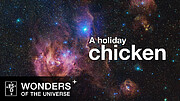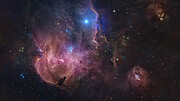Videos

The 1.5-billion-pixel Running Chicken Nebula
3D animation of the Running Chicken Nebula
While many holiday traditions involve
feasts of turkey, soba noodles, latkes or Pan de Pascua, this year, the
European Southern Observatory (ESO) is bringing you a holiday chicken.
The so-called Running Chicken Nebula, home to young stars in the making,
is revealed in spectacular detail in this 1.5-billion-pixel image
captured by the VLT Survey Telescope (VST), hosted at ESO’s Paranal site
in Chile.
This vast stellar nursery is located in the constellation
Centaurus (the Centaur), at about 6500 light-years from Earth. Young
stars within this nebula emit intense radiation that makes the
surrounding hydrogen gas glow in shades of pink.
The Running Chicken Nebula actually comprises several
regions, all of which we can see in this vast image that spans an area
in the sky of about 25 full Moons
[1].
The brightest region within the nebula is called IC 2948, where some
people see the chicken’s head and others its rear end. The wispy pastel
contours are ethereal plumes of gas and dust. Towards the centre of the
image, marked by the bright, vertical, almost pillar-like, structure, is
IC 2944. The brightest twinkle in this particular region is
Lambda Centauri, a star visible to the naked eye that is much closer to us than the nebula itself.
There are, however, many young stars within IC 2948 and IC
2944 themselves — and while they might be bright, they’re most certainly
not merry. As they spit out vast amounts of radiation, they carve up
their environment much like, well, a chicken. Some regions of the
nebula, known as
Bok globules,
can withstand the fierce bombardment from the ultraviolet radiation
pervading this region. If you zoom in to the image, you might see them:
small, dark, and dense pockets of dust and gas dotted across the nebula.
Other regions pictured here include, to the upper right,
Gum 39 and 40, and to the lower right, Gum 41. Aside from nebulae, there
are countless orange, white and blue stars, like fireworks in the sky.
Overall in this image, there are more wonders than can be described —
zoom in and pan across, and you’ll have a feast for the eyes.
This image is a large mosaic comprising hundreds of
separate frames carefully stitched together. The individual images were
taken through filters that let through light of different colours, which
were then combined into the final result presented here. The
observations were conducted with the wide-field camera
OmegaCAM on the
VST,
a telescope owned by the National Institute for Astrophysics in Italy
(INAF) and hosted by ESO at its Paranal site in Chile’s Atacama Desert
that is ideally suited for mapping the southern sky in visible light.
The data that went into making this mosaic were taken as part of the VST
Photometric Hα Survey of the Southern Galactic Plane and Bulge (
VPHAS+), a project aimed at better understanding the life cycle of stars.
Notes
[1] This image, edge to
edge, is 270 light-years wide. It would take an average chicken almost
21 billion years to run across it. That’s much longer than our Universe
has been around for.
More information
The European Southern Observatory (ESO)
enables scientists worldwide to discover the secrets of the Universe for
the benefit of all. We design, build and operate world-class
observatories on the ground — which astronomers use to tackle exciting
questions and spread the fascination of astronomy — and promote
international collaboration for astronomy. Established as an
intergovernmental organisation in 1962, today ESO is supported by 16
Member States (Austria, Belgium, the Czech Republic, Denmark, France,
Finland, Germany, Ireland, Italy, the Netherlands, Poland, Portugal,
Spain, Sweden, Switzerland and the United Kingdom), along with the host
state of Chile and with Australia as a Strategic Partner. ESO’s
headquarters and its visitor centre and planetarium, the ESO Supernova,
are located close to Munich in Germany, while the Chilean Atacama
Desert, a marvellous place with unique conditions to observe the sky,
hosts our telescopes. ESO operates three observing sites: La Silla,
Paranal and Chajnantor. At Paranal, ESO operates the Very Large
Telescope and its Very Large Telescope Interferometer, as well as survey
telescopes such as VISTA. Also at Paranal ESO will host and operate the
Cherenkov Telescope Array South, the world’s largest and most sensitive
gamma-ray observatory. Together with international partners, ESO
operates ALMA on Chajnantor, a facility that observes the skies in the
millimetre and submillimetre range. At Cerro Armazones, near Paranal, we
are building “the world’s biggest eye on the sky” — ESO’s Extremely
Large Telescope. From our offices in Santiago, Chile we support our
operations in the country and engage with Chilean partners and society.
Links
Contacts
Juan Carlos Muñoz Mateos
ESO Media Officer
Garching bei München, Germany
Tel: +49 89 3200 6176
Email: jmunoz@eso.org
Bárbara Ferreira
ESO Media Manager
Garching bei München, Germany
Tel: +49 89 3200 6670
Cell: +49 151 241 664 00
Email: press@eso.org























